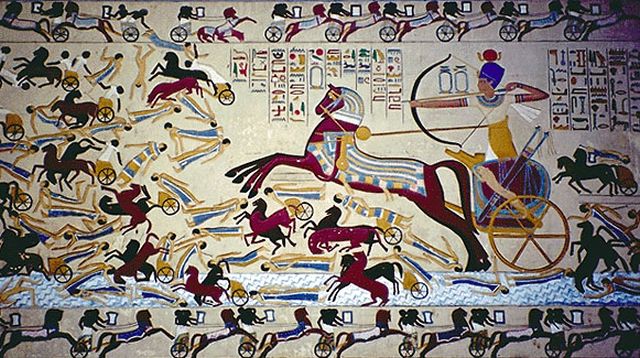November 2, 2016
The Hyksos: Conquerors of Middle Kingdom Egypt

Archaeologists have discovered that, at the beginning of the MB II B period (Bronze Age between 1750-1650 B.C.E.), a new form of warrior enter Palestine from the East and went all the way south into Egypt. The Egyptians gave these people the name of Hyksos, meaning conquerors of foreign lands or Shepherd Kings. They ruled an empire that contained Egypt and the territories that surrounded it. When the Hyksos took control over the territory, they tried to destroy all the monuments, kill every native person, and erase Egyptian beliefs into theirs, starting a new era in Egypt.1

Archaeologists describe the Hyksos as a group identified as multi-ethnic that come from West Asia. The Hyksos conquered the Nile Delta and the rest of Egypt. At that time, Egypt was divided into two major regions, Lower Egypt, which was North Egypt, and Upper Egypt which was South Egypt.2 The Hyksos took control over Egypt with a massive army made up of foreign warriors that had no mercy for their enemies. They destroyed everything that got in their way: cities, temples, and houses; and they overran the lands as well. The Hyksos were successful with their attacks. They revolutionized methods of warfare. The Hyksos modified their bows to be more precise and deadly, as well as modifying arrowheads, daggers, swords, and shields. Most importantly, they used the horse war chariot, which made them famous and caused fear among the Egyptians.3 The Hyksos used several cities for different purposes, and all of them equally important. Memphis was the actual capital of the Hyksos. The city of Avaris was a camp located in Lower Egypt, where the government was located. Immense walls were built around the city to fortify it. These walls were forty-five feet high and six feet wide; these walls still exist today. Heliopolis was a city built dedicated for religious purposes only.4
Salatis was the name of the first Hyksos king to rule Upper and Lower Egypt. After conquering both parts of Egypt, he fortified the eastern frontier. Salatis was scared of the Assyrians. They were a group of people who were growing in power and were causing some fear to the kingdom of Salatis. After Salatis died, three dynasties of Hyksos followed him. The last to ruled the Hyksos was a man named Joseph. At the end of Joseph’s reign, the Thebans declared their independence from the Hyksos kingdom. The Thebans were a group of people that had some control over Upper Egypt and who did not like the way the Hyksos ruled. After the Thebans won the war, they decided to expel all the Hyksos from the lands of Egypt, making the Hyksos just another falling kingdom.5
- William Stevenson Smith, “Review of The Rise and Fall of the Middle Kingdom in Thebes,” American Journal of Archaeology vol. 52 no. 2 (1948): 305. ↵
- Carol A. Redmount, “Ethnicity, pottery, and the Hyksos at Tell El-Maskhuta in the Egyptian Delta,” Biblical Archaeologist 58, no. 4 (1995): 182. ↵
- William J. Murnane, “The Second Stela of Kamose and His Struggle against the Hyksos Ruler and His Capital Labib Habachi,” Journal Of Near Eastern Studies 37, no. 3 (1978): 277. ↵
- William H. Stiebing, “Hyksos burials in Palestine: a review of the evidence,” Journal Of Near Eastern Studies no. 2 (1971): 110-13. ↵
- William Stevenson Smith, “Review of The Rise and Fall of the Middle Kingdom in Thebes,” American Journal of Archaeology vol. 52 no. 2 (1948): 306. ↵
Tags from the story
Egyptian Middle Kingdom
Hyksos